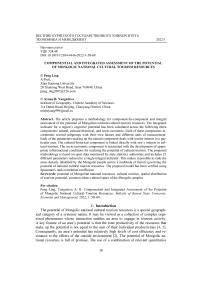Componential and integrated assessment of the potential of Mongolic national cultural tourism resources
Автор: Peng Ling, Yangutova Ayana B.
Статья в выпуске: 1, 2022 года.
Бесплатный доступ
The article proposes a methodology for component-by-component and integral assessment of the potential of Mongolian national cultural tourism resources. The integrated indicator for a region’s cognitive potential has been calculated across the following three components: natural, cultural-historical, and socio-economic. Each of these components incorporates several subgroups with their own factors and different units of measurement. Each of the parameters making up the natural component deals with tourist interest in a particular area. The cultural-historical component is linked directly with one’s interest in cultural tourism. The socio-economic component is associated with the development of appropriate infrastructural conditions for realizing the potential of cultural tourism. The proposed methodology is based on open data monitored by state statistics authorities and includes 23 different parameters reduced to a single integral indicator. This makes it possible to rank the areas densely inhabited by the Mongolic people across a multitude of factors governing the potential of national cultural tourism resources. The proposed model has been verified using Spearman's rank correlation coefficient.
Potential of mongolian national resources, cultural tourism, spatial distribution of tourism potential, common ethno-cultural space of the mongolic peoples
Короткий адрес: https://sciup.org/148323768
IDR: 148323768 | УДК: 338.48 | DOI: 10.18101/2304-4446-2022-1-58-69
Список литературы Componential and integrated assessment of the potential of Mongolic national cultural tourism resources
- Dagbaeva S.D.-N., Tsyrenov D.D. Integration activity of the states and regions of Russia within the Great Silk Road // Espacios, 2019, 40(22). pp. 24
- Dirin, D. A., & Kuskov, A. S. (2011). Analiz metodik kompleksnoi otsenki turistsko-rekreatsionnogo potentsiala territorii [An analysis of methodologies for integrated assessment of the tourism-and-recreation potential of an area]. In Sovremennye problemy geografii: Sbornik nauchnykh trudov [Current issues in geography: A collection of scholarly works] (pp. 70-79). Saratov, Russia: SO EAGO. (in Russian).
- Dunets, A. N., Krupochkin, E. P., & Tel'tsova, A. A. Nekotorye metodicheskie aspekty otsenki turistsko-rekreatsionnogo potentsiala dlya tselei territorial'nogo planirovaniya [Certain methodological aspects of assessing the tourism-and-recreation potential for the purposes of territorial planning]. Izvestiya Altaiskogo Gosudarstvennogo Universiteta, 3-2, 108-113. (in Russian).
- Fedulin, A. A., Gavrilov, A. Yu., & Novikova, N. G. (2012). Sovremennye podkhody k opredeleniyu resursnogo potentsiala tourisma [The latest approaches to determining the resource potential of tourism]. ServisPlus, 1, 38-44. (in Russian).
- Klochkov, V. A. (1996). Opredelenie prirodno-resursnogo potentsiala territorii kak element optimizatsii prirodopol'zovaniya [Determination of an area's natural-resource potential as an element of optimizing the use of natural resources]. In Territorial'naya organizatsiya ob-shchestva i upravleniya v regionakh [The territorial organization of society and administration in regions] (pp. 107-109). Voronezh, Russia: VGPU. (in Russian).
- Kudryavtsev, A. F., Sidorov, V. P., Skobeleva, O. A. (2006). Vybor operatsionno-territorial'nykh edinits pri otsenke rekreatsionnogo potentsiala [The selection of operational-territorial units in assessing recreational potential]. In Tourism i regional'noe razvitie. Sbornik nauchnykh statei. Vypusk 4 [Tourism and regional development: A collection of scholarly articles. Issue 4] (pp. 85-88). Smolensk, Russia: Universum. (in Russian).
- Mos'kina, I. Yu. (2013). Analiz sootvetstviya turistskoi deyatel'nosti v Pribaikal'skom regione kriteriyam ustoichivosti [An analysis of the degree to which tourism activity in the Baikal region matches the sustainability criteria]. Izvestiya Irkutskoi Gosudarstvennoi Ekonomicheskoi Akademii (Baikal'skii Gosudarstvennyi Universitet Ekonomiki i Prava), 6, 6. (in Russian).
- Sokolova, N. V. (1988). Prirodno-resursnyi potentsial territorii: Soderzhanie ponyati-ya, metody otsenki [An area's natural-resource potential: Its concept and methods for assessing it]. VestnikLeningradskogo Universiteta. Seriya 7, 3, 125-130. (in Russian).
- Starkova, I. I., Krylasova, E. A., & Dorzhieva, L. G. (2020). Vodnyi tourism kak odno iz napravlenii v rekreatsii [Nautical tourism as an area in recreation]. Vestnik Buryatskogo Gosudarstvennogo Universiteta. Ekonomika i Menedzhment, 2, 34-40. (in Russian).
- Tsyrenov D.D. The Republic of Buryatia in the new space of Siberia and the Far East // Espacios, 2019, 40(20). pp. 28
- Tsyrenov D.D., Slepneva L.R. Forecasting the socio-economic development of the Republic of Buryatia in the context of labor potential // International Journal of Mechanical Engineering and Technology, 2018, 9(11), pp. 2070-2075


